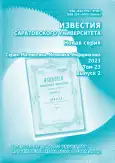Optimal solution in the model of control over an economic system in the condition of a mass disease
- Authors: Lutoshkin I.V.1, Rybina M.S.1
-
Affiliations:
- Ulyanovsk State University
- Issue: Vol 23, No 2 (2023)
- Pages: 264-273
- Section: Articles
- URL: https://journal-vniispk.ru/1816-9791/article/view/250848
- DOI: https://doi.org/10.18500/1816-9791-2023-23-2-264-273
- EDN: https://elibrary.ru/BTQTSM
- ID: 250848
Cite item
Full Text
Abstract
About the authors
Igor Viktorovich Lutoshkin
Ulyanovsk State UniversityRussia, 432970, Ul'yanovsk, L. Tolstogo st., 42
Maria Sergeevna Rybina
Ulyanovsk State UniversityRussia, 432970, Ul'yanovsk, L. Tolstogo st., 42
References
- Kul’kova I. A. The coronavirus pandemic influence on demographic processes in Russia. Human Рrogress, 2020, vol. 6, iss. 1, pp. 2–11 (in Russian). https://doi.org/10.34709/IM.161.5
- Bobkov A. V., Vereshchagina V. K. Correctional dynamics of economic activity under the influence of measures to control the pandemic. Innovation and Investment, 2020, vol. 8, pp. 94–98 (in Russian). EDN: LHLLQP
- Funk S., Gilad E., Watkins C., Jansen V. A. A. The spread of awareness and its impact on epidemic outbreaks. Proceedings of the National Academy of Sciences, 2009, vol. 106, iss. 16, pp. 6872–6877. https://doi.org/10.1073/pnas.0810762106
- Wani A. U., Bakshi A., Wani M. A. Dynamics of COVID-19: Modelling and analysis. Journal of Infectious Diseases and Epidemiology, 2020, vol. 6, pp. 1–11. https://doi.org/10.23937/2474-3658/1510128
- Arino J., Brauer F., van den Driessche P., Watmough J., Wu J. Simple models for containment of a pandemic. Journal of the Royal Society Interface, 2006, vol. 3, iss. 8, pp. 453–457. https://doi.org/10.1098/rsif.2006.0112
- Atkeson A. What will be the economic impact of Covid-19 in the US? Rough estimates of disease scenarios. NBER Working Papers, 2020, Art. 26867. Available at: https://www.nber.org/system/files/working_papers/w26867/w26867.pdf (accessed May 29, 2021).
- Brauer F., Castillo-Chavez C. Mathematical Models in Population Biology and Epidemiology. Texts in Applied Mathematics, vol. 40. New York, Springer, 2012. 508 p. https://doi.org/10.1007/978-1-4614-1686-9
- Britton N. F. Essential Mathematical Biology. London, Springer, 2003. 335 p. https://doi.org/10.1007/978-1-4471-0049-2
- Castillo-Chavez C., Blower S., van den Driessche P., Kirschner D., Yakubu A. A. (eds.) Mathematical Approaches for Emerging and Reemerging Infectious Diseases: Models, Methods, and Theory. The IMA Volumes in Mathematics and its Applications, vol. 126. New York, Springer, 2002. 377 p. https://doi.org/10.1007/978-1-4613-0065-6
- He S., Tang S., Rong L. A discrete stochastic model of COVID-19 outbreak: Forecast and control. Mathematical Biosciences and Engineering, 2020, vol. 17, iss. 4, pp. 2792–2804. https://doi.org/10.3934/mbe.2020153
- Volz E., Meyers L. A. Susceptible-infected-recovered epidemics in dynamic contact networks. Proceedings of the Royal Society B, 2007, vol. 274, iss. 1628, pp. 2925–2934. https://doi.org/10.1098/rspb.2007.1159
- Matveev A. V. The mathematical modeling of the effective measures against the COVID-19 spread. National Security and Strategic Planning, 2020, vol. 2020, iss. 1 (29), pp. 23–39 (in Russian). https://doi.org/10.37468/2307-1400-2020-1-23-39
- Rybina M. S. Mathematical model of optimal resource control in conditions of a pandemic. Proceedings of the International Youth Scientific Forum “LOMONOSOV–2021” 2021 (in Russian). Available at: https://lomonosov-msu.ru/archive/Lomonosov_2021/data/22519/127569_uid543558_report.pdf (accessed May 29, 2021).
- Rybina M. S. The problem of estimating the parameters of the mathematical model of the impact of the pandemic on the economy. Collection of Abstracts of the Congress of Young Scientists (ITMO University), 2021 (in Russian). Available at: https://kmu.itmo.ru/digests/article/7045 (accessed May 29, 2021).
- Igret Araz S. Analysis of a Covid-19 model: Optimal control, stability and simulations. Alexandria Engineering Journal, 2020, vol. 60, iss. 1, pp. 647–658. https://doi.org/10.1016/j.aej.2020.09.058
- Macalisang J., Caay M., Arcede J., Caga-Anan R. Optimal control for a COVID-19 model accounting for symptomatic and asymptomatic. Computational and Mathematical Biophysics, 2020, vol. 8, pp. 168–179. https://doi.org/10.1515/cmb-2020-0109
- Ovsyannikova N. I. Problem of optimal control of epidemic in view of latent period. Civil Aviation High Technologies, 2017, vol. 20, iss. 2, pp. 144–152. EDN: YLJOFL
- Zamir M., Abdeljawad T., Nadeem F., Khan A., Yousef A. An optimal control analysis of a COVID-19 model. Alexandria Engineering Journal, 2021, vol. 60, iss. 2, pp. 2875–2884. https://doi.org/10.1016/j.aej.2021.01.022
- Andreeva E. A., Semykina N. A. Optimal control of the spread of an infectious disease with allowance for an incubation period. Computational Mathematics and Mathematical Physics, 2005, vol. 45, iss. 7, pp. 1133–1139. EDN: LJBSEB
- Lutoshkin I. V. The parameterization method for optimizing the systems which have integro-differential equations. The Bulletin of Irkutsk State University. Series Mathematics, 2011, vol. 4, iss. 1, pp. 44–56 (in Russian). EDN: NQWBZH
- Samarskiy A. A. Vvedenie v chislennye metody [Introduction to Numerical Methods]. St. Petersburg, Lan’, 2005. 288 p. (in Russian). EDN: QJODBV
Supplementary files










